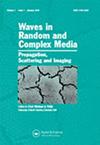大气边界层声学相位差的非马尔可夫行为
3区 物理与天体物理
Q1 Engineering
引用次数: 0
摘要
马尔可夫近似被广泛应用于随机介质中的波传播。如果传播路径长度大于影响波场特定统计矩的介质不均匀性尺度,并且在此尺度上统计矩的变化微不足道,则该近似有效。对于在大气湍流中传播的声信号的相位波动方差和其他统计矩来说,这些条件可能会被违反:最大漩涡的尺度可达数百米,声折射率的波动也相对较强。本文在不使用马尔可夫近似的情况下,计算了统计不均匀湍流中球形声波的相位方差。对于小于最大漩涡尺度的传播范围,不使用马尔可夫近似的相位方差明显小于使用马尔可夫近似时的相位方差。随着传播范围的增大,两个结果之间的差异趋向于一个恒定值("记忆 "效应),这在许多应用中可能非常重要。不使用马尔可夫近似法的相位方差与声音在大气中传播的实验数据更为吻合,而使用该近似法计算的方差则明显高估了数据。本文章由计算机程序翻译,如有差异,请以英文原文为准。
Non-Markov behavior of acoustic phase variance in the atmospheric boundary layer
The Markov approximation is widely used in wave propagation in random media. This approximation is valid if the propagation path length is greater than the scale of the medium inhomogeneities affecting a particular statistical moment of a wave field and the moment changes insignificantly over this scale. These conditions might be violated for the variance of the phase fluctuations and other statistical moments of acoustic signals that have propagated through atmospheric turbulence: the scale of the largest eddies can be hundreds of meters, and fluctuations in the acoustic refractive index are relatively strong. In the current article, the phase variance of a spherical sound wave in statistically inhomogeneous turbulence is formulated without the Markov approximation. For propagation ranges smaller than the scale of the largest eddies, the phase variance without the Markov approximation is significantly smaller than when this approximation is employed. As the range increases, the difference between the two results tends toward a constant value (a ‘memory’ effect), which might be significant in many applications. The phase variance without the Markov approximation agrees better with the experimental data on sound propagation through the atmosphere, while the variance calculated with this approximation significantly overpredicts the data.
求助全文
通过发布文献求助,成功后即可免费获取论文全文。
去求助
来源期刊

Waves in Random and Complex Media
物理-物理:综合
自引率
0.00%
发文量
677
审稿时长
3.0 months
期刊介绍:
Waves in Random and Complex Media (formerly Waves in Random Media ) is a broad, interdisciplinary journal that reports theoretical, applied and experimental research related to any wave phenomena.
The field of wave phenomena is all-pervading, fast-moving and exciting; more and more, researchers are looking for a journal which addresses the understanding of wave-matter interactions in increasingly complex natural and engineered media. With its foundations in the scattering and propagation community, Waves in Random and Complex Media is becoming a key forum for research in both established fields such as imaging through turbulence, as well as emerging fields such as metamaterials.
The Journal is of interest to scientists and engineers working in the field of wave propagation, scattering and imaging in random or complex media. Papers on theoretical developments, experimental results and analytical/numerical studies are considered for publication, as are deterministic problems when also linked to random or complex media. Papers are expected to report original work, and must be comprehensible and of general interest to the broad community working with wave phenomena.
 求助内容:
求助内容: 应助结果提醒方式:
应助结果提醒方式:


